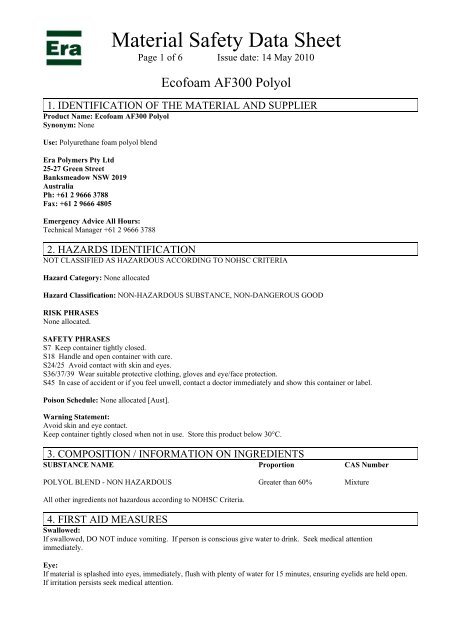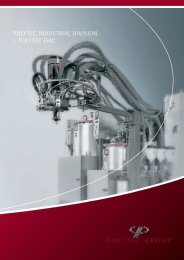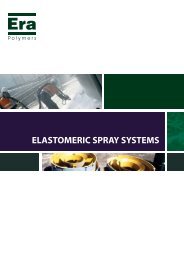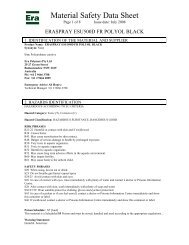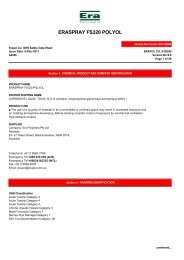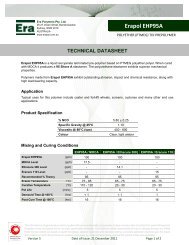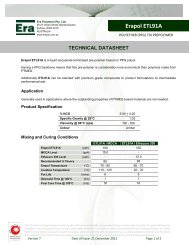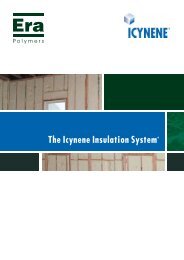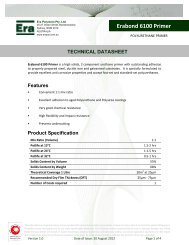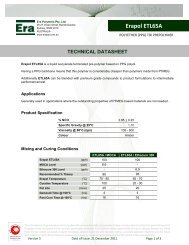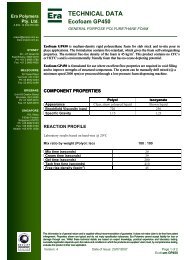Material Safety Data Sheet - Era Polymers
Material Safety Data Sheet - Era Polymers
Material Safety Data Sheet - Era Polymers
You also want an ePaper? Increase the reach of your titles
YUMPU automatically turns print PDFs into web optimized ePapers that Google loves.
<strong>Material</strong> <strong>Safety</strong> <strong>Data</strong> <strong>Sheet</strong>Page 2 of 6 Issue date: 14 May 2010Ecofoam AF300 PolyolSkin:If material is splashed onto the skin, remove any contaminated clothing and wash skin thoroughly with water and soap.Flush skin with water. Seek medical attention if irritation persists after washing.Inhaled:Remove victim to fresh air. Apply resuscitation if victim is not breathing. If trained personnel available administeroxygen if breathing is difficult.First Aid Facilities:Eye wash fountain, safety shower and normal washroom facilities.Advice to Doctor:Treat symptomatically.In case of poisoning, contact Poisons Information CentreIn Australia call Tel: 131126In New Zealand Tel: 0347470005. FIRE-FIGHTING MEASURESFire/Explosion HazardIf safe to do so, move undamaged containers from fire area.FIRE FIGHTING PROCEDURES: Fire fighters to wear Self-Contained Breathing Apparatus (SCBA) in confinedspaces, in oxygen deficient atmospheres or if exposed to products of decomposition. Full protective clothing is alsorecommended.EXTINGUISHING MEDIA: Use extinguishing media suitable for surrounding fire situation. Use foam, water spray(fog), CO2 or dry powder. Use water spray to cool fire-exposed containers and for large fires.HAZARDOUS DECOMPOSITION PRODUCTS: Decomposes on heating emitting toxic and/or irritating fumesincluding carbon monoxide and carbon dioxide.UNUSUAL FIRE AND EXPLOSION HAZARDS: In use, product may form flammable vapour-air mixtures. Heatingmay cause expansion or decomposition of material leading to violent rupture of containers. Product contains lowboiling substances - containers may rupture due to pressure build-up under fire condition.HAZCHEM CODE: None allocated [Aust]FLAMMABILITYThis product is not flammable. This product is combustible - avoid exposure to heat, flames and ignition sources.There may be a slight fire hazard when this product is exposed to heat or flame. Ignition sources such as naked flames,sparks, or hot surfaces (>500°C) should be avoided. Low energy ignition sources such as electrostatic discharges fromsurfaces or people should not pose a significant risk.6. ACCIDENTAL RELEASE MEASURESRemove all sources of heat and ignition. Ventilate area. Clean-up all spills immediately. <strong>Material</strong> may be slipperywhen spilt. Walk cautiously. Wear protective equipment to prevent skin and eye contact, as outlined in Section 8 ofthis <strong>Material</strong> <strong>Safety</strong> <strong>Data</strong> <strong>Sheet</strong>. Contain and absorb spill with sand, earth, vermiculite, or other inert material. Preventrun-off from entering drains, sewers or waterways. Use clean, non-sparking tools to collect absorbed material and placein properly labelled containers for disposal.7. HANDLING AND STORAGEStore in a cool, dry, well-ventilated place. Store away from sources of heat or ignition. Store below 30°C. Store awayfrom incompatible materials. Store in tightly sealed containers. The containers should be protected from excessive heatand direct sunlight. Protect containers against physical damage and check regularly for leaks. The containers shouldnot be left open and should be tightly closed after use. Store in original containers as approved by manufacturer. Ventcontainers carefully, as needed to relieve pressure. Do not eat, drink or smoke in the workplace.
<strong>Material</strong> <strong>Safety</strong> <strong>Data</strong> <strong>Sheet</strong>Page 3 of 6 Issue date: 14 May 2010Ecofoam AF300 Polyol8. EXPOSURE CONTROLS / PERSONAL PROTECTIONExposure StandardsNo exposure standards are available for this product, however, the following exposure standards have been assigned by[NOHSC] to the following components of the product:***************************POLYOL BLEND - NON HAZARDOUSNo Exposure details availableEngineering ControlsMaintain adequate ventilation at all times. In most circumstances natural ventilation systems are adequate unless thematerial is heated, reacted or otherwise changed in some type of chemical reaction, then the use of a local exhaustventilation system is recommended. If exhaust ventilation is not available or inadequate, use approved respirator toAustralian Standards.Personal Protection EquipmentCLOTHING: Wear suitable protective clothing to prevent skin contact.GLOVES: Wear impervious gloves to prevent skin contact - PVC or natural rubber.EYES: Wear safety glasses with side shields, chemical goggles or face shield to protect eyes.RESPIRATORY PROTECTION: Where required, select and use respirators in accordance with AS/NZS 1715/1716.The use of a respirator for organic vapours with disposable or with replaceable filters is recommended. Filter capacityand respirator type depends on exposure levels and type of contaminant. If entering spaces where the airborneconcentration of a contaminant is unknown then the use of a Self-contained breathing apparatus (SCBA) with positivepressure air supply complying with AS/NZS 1715 / 1716, or any other acceptable International Standard isrecommended.9. PHYSICAL AND CHEMICAL PROPERTIESAppearance:Honey-coloured liquidBoiling Point Melting Point: Not determinedVapour Pressure: 2.37 psi @ 50°CSpecific Gravity: 1.15 @ 20°CFlash Point: > 61°CFlammability Limits:Not determinedSolubility in Water:Not determinedOther PropertiesNone determined.10. STABILITY AND REACTIVITYSTABILITY:Stable under normal conditions of use. Store below 30°C.HAZARDOUS DECOMPOSITION PRODUCTS:Emits toxic and/or irritating fumes including carbon monoxide and carbon dioxide when heated to decomposition.HAZARDOUS POLYMERIZATION:Will not occur under normal conditions of use.INCOMPATIBILITIES:Strong alkalis, acids, oxidizing agents.CONDITIONS TO AVOID:Heat, flames, ignition sources and incompatibles. Avoid temperatures above 30°C.
<strong>Material</strong> <strong>Safety</strong> <strong>Data</strong> <strong>Sheet</strong>Page 4 of 6 Issue date: 14 May 2010Ecofoam AF300 Polyol11. TOXICOLOGICAL INFORMATIONNo adverse health effects are expected, if the product is handled in accordance with this <strong>Material</strong> <strong>Safety</strong> <strong>Data</strong> <strong>Sheet</strong> andthe product label. Symptoms and effects that may arise if the product is mishandled and overexposure occurs are:ACUTE HEALTH EFFECTS:Swallowed:May cause irritation to mouth, throat and stomach with effects including mucous build up, irritation to the tongue andlips and pains in the stomach, which may lead to nausea, vomiting and diarrhoea.Eye:May cause irritation to the eyes, with effects including: tearing, pain, stinging and blurred vision.Skin:May cause irritation to the skin, with effects including: redness and itchiness.Inhaled:May cause irritation to the nose, throat and respiratory system with effects including: dizziness, headache and loss ofco-ordination.Chronic:Prolonged or repeated skin contact may lead to dermatitis.Toxicological <strong>Data</strong>:There is no other toxicological information available for this product.12. ECOLOGICAL INFORMATIONEcotoxity:There is no information available for this product.Mobility:There is no information available for this product.Persistence / Degradability:There is no information available for this product.Chemical Fate Information:There is no ecological information available for this product, however, large quantities should not be discharged intodrains, sewers or waterways.13. DISPOSAL CONSIDERATIONSDispose of in accordance with all relevant Local, State and Federal regulations. Dispose of material through a licensedwaste contractor. Any processing, use, or contamination of this product may change the requirements for disposal. It isthe responsibility of the generator of the waste to properly classify, transport and dispose of the waste.14. TRANSPORT INFORMATIONRoad TransportUN Number: None allocatedProper Shipping Name: NONE ALLOCATEDDangerous Goods Class: None allocatedPacking Group: None allocatedLabel: None allocated
<strong>Material</strong> <strong>Safety</strong> <strong>Data</strong> <strong>Sheet</strong>Page 5 of 6 Issue date: 14 May 2010Air TransportUN Number: None allocatedProper Shipping Name: NONE ALLOCATEDDangerous Goods Class: None allocatedPacking Group: None allocatedLabel: None allocatedSea TransportUN Number: None allocatedProper Shipping Name: NONE ALLOCATEDDangerous Goods Class: None allocatedPacking Group: None allocatedLabel: None allocated15. REGULATORY INFORMATIONPoison Schedule: None allocated [Aust]Ecofoam AF300 PolyolInventory Status:Inventory StatusAustralia (AICS)YY = all ingredients are on the inventory.16. OTHER INFORMATIONDate of Preparation:Issue date: 14 May 2010Supersedes: October 2006Reasons for Update:Periodic reviewKey Legend Information:NOHSC - National Occupational Health & <strong>Safety</strong> Commission {Formerly Worksafe}[Aust]SUSDP - Standard for the Uniform Scheduling of Drugs and Poisons [Aust]TWA - Time Weighted Average [Int]STEL - Short Term Exposure Limit [Int]AICS - Australian Inventory of Chemical SubstancesEPA - Environmental Protection Agency [Int]NIOSH - National Institute for Occupational <strong>Safety</strong> and Health [US]AS/NZS 1715 - Selection, use and maintenance of respiratory protective devices. [Aust/NZ]AS/NZS 1716 - Respiratory protective devices. [Aust/NZ]IATA - International Aviation Transport Authority [Int]ICAO - International Civil Aviation Organization [Int]IMO - International Maritime Organisation. [Int]IMDG - International Maritime Dangerous Goods [Int]United Nations Recommendations for the Transport of Dangerous Goods and Globally Harmonized System for theclassification and labelling of Chemicals. [Int]EU - European Union[Aust/NZ] = Australian New Zealand[Int] = International[US] = United States of AmericaRemoval of the heading of Poison Schedule [Aust], in section 3 and 15 of this <strong>Material</strong> <strong>Safety</strong> <strong>Data</strong> <strong>Sheet</strong> (MSDS)makes this a valid health and safety document in other international jurisdictions/countries. For full compliance pleasecontact your Federal, State or Local regulators for further information.
<strong>Material</strong> <strong>Safety</strong> <strong>Data</strong> <strong>Sheet</strong>Page 6 of 6 Issue date: 14 May 2010Ecofoam AF300 PolyolDisclaimerThis MSDS summarises our best knowledge of the health and safety hazard information available on the product andthe measures to be used to handle and use the product safely. Each user should read this MSDS and consider theinformation in connection with the way the product is intended to be handled or used.Principal References:Information supplied by manufacturer, reference sources including the public domain.END OF MSDS


